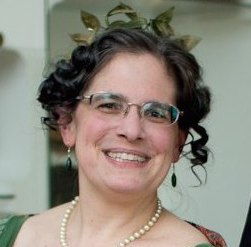- Era: 1850s-1870s
A short, performance-oriented summary for those who want to skip the background and just go out and schottische. This is intended as a summary for those already generally familiar with couple dancing, not as a way for new dancers to learn from scratch; a live teacher is always to be preferred to a written description.
A fuller discussion of and list of sources for the schottische may be found in The Early Schottische.
Take partner in waltz (closed hold) position, gentleman facing along the line of dance. Feet are given for the gentleman; lady dances opposite. There are two parts to the dance, generally danced in regular alternating sequence.
Part 1 (balancée)
- Slide left foot to the left, towards the center of the room
- Close the right foot into third behind the left
- Slide the left foot to the left again
- Hop on the left foot, tucking the right behind the left in raised third
Repeat, leading with the right foot and moving to the right, towards the outside of the room. The overall motion is a shallow zigzag along the line of dance.
- Older version: turn so the gentleman faces the outside of the room; steps move along the line of dance and then against the line of dance. Traffic jams and/or accidents will ensue unless the entire room does this variation at once. In practice, this just does not happen at balls, so this variation is generally avoided except in a performance context.
- Less common turning variation: turn so the gentleman faces the outside of the room; dance this part as a slow polka turn, with the gentleman sliding his left foot across the line of dance on count 3 (the lady slides her right foot straight forward along the line of dance, between his feet) and completing the half-turn on the hop on 4. Repeat on the other foot (lady slides left foot across line of dance, gentleman right along it) to complete the turn.
- More challenging: turn in reverse (dancer leading with right foot slides it across line of dance while dancer leading with left foot slides it along line of dance between partner’s feet).
- Rare Polish-Parisian variation: count 3 is a leap rather than a slide. Murmur "Gawlikowski" and look knowledgeable.
Part 2 (sauteuse)
- Leap left across line of dance (lady leaps right along line of dance, between gent’s feet)
- Hop on left foot, tucking the right foot behind the left in third position raised, finishing a half-turn
- Leap right along line of dance, between lady’s feet (lady leaps left across line of dance)
- Hop on right foot, tucking the left foot behind as before, to complete the turn
Repeat all of the above for a second complete turn.
- Lazier, later, and rare variation: simply step instead of leap.
- Even lazier and rarer variation: make quarter-turns every two counts for one full rotation instead of two.
- Advance or retire (pursuit): do not turn; one person moves forward along the line of dance while the other moves backwards (backing the lady or backing the gent). Add flair by having the advancing partner extend their free foot very slightly forward on the hopping steps while the retreating partner extends theirs backwards. This must be done carefully to avoid kicking one’s partner.
- Challenge: turn in reverse; the dancer stepping with the right foot steps across line of dance while the dancer stepping with the left foot steps along line of dance, between partner’s feet.
Rhythm variations
- Extremely common: use the valse à deux temps for part 2:
1-and-2 Slide-close-slide (half turn; on 2 gent slides left foot across line of dance, lady slides right foot along line of dance between his feet; complete the turn on the final "and" of the measure)
3-and-4 Slide-close-slide (half turn, each dancing the other’s steps from of the previous half-turn)
Repeat this sequence once more for a second complete turn.
- Rare: use the valse à deux temps for part 1; as above, but replacing the first part instead of the second.
- Speculative variation: use a four-slide galop in part 1 as follows:
1-and-2-and-3-and-4 Slide-close-slide-close-slide-close-slide, turning halfway at the end as in the valse à deux temps.
Repeat, reversing feet and moving "over elbows" to complete a single turn.
Pattern variations
- Double the schottische: dance part 1 twice followed by part 2 twice. The gentleman may cue his partner by murmuring "double" if he feels unable to simply lead this variation.
- Valse à deux temps copout: use this step, turning, throughout, skipping the schottische-specific steps altogether.
Variations to avoid
- The Military Schottische (partners side by side to start); this seems to have developed and become popular in the 1880s.
- Anything where the couple separates from one another. A chance to hold onto each other was part of the fun of couple dances in this era!


Leave a Reply